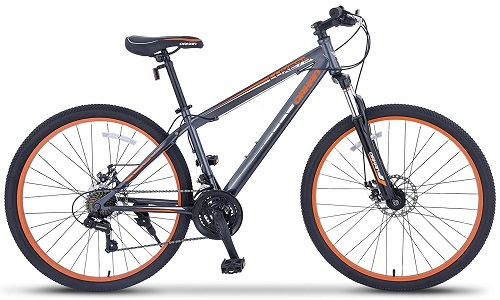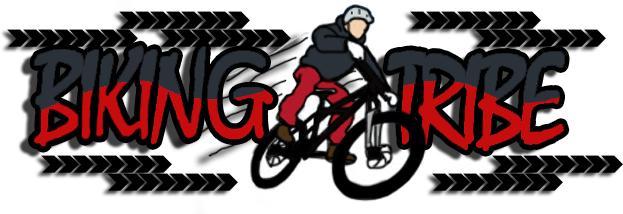- You are here:
- Home »
- Mountain Bikes
- » Best Budget Mountain Bike 2017

Best Budget Mountain Bike 2017
We all know people who have spent more on their road bikes or mountain bikes than on their cars. It’s not uncommon for people to name their bikes, and to treat them like cherished family members. But for those of us new to trudging up mountains for hours only to speed down them, unable to check out the scenery because it’s zooming by so fast, for those of us, in other words, who would like a taste of the sport without shelling out thousands of dollars…well, we’re looking for something a bit cheaper. Some find their first mountain bike for fifty bucks at a garage sale, while others shop around for weeks on craigslist and other sites until the perfect bike pops up, then meet up and exchange cash with a stranger on a bike we know next to nothing about (unless you bring a mountain biker friend along with you who knows her stuff). For most of us, though, we prefer to do a little research online to make sure we end up with the best budge mountain bike out there. In 2017, there were a lot of great (and some not-so-great) bikes.
Mountain biker culture is incredible, and buying your first bike can be a great way to enter into a community of great people. Often bike shops will run a weekly or bimonthly group ride that anyone can join, or will be a great source of maps and information on where to ride, simpler trails that are great if you are just starting out. You can also check facebook for mountain biking groups if you’re knew or if you simply want more folks to ride with.
Bad bikes are as common as sandflies in the Milford Sound. The internet is just crawling with them. Here are a few ideas to keep you on the straight and narrow when it comes to finding a bike, whether you’re dipping your toe into mountain biking, coming back after an injury, or upgrading from an outdated and outridden model.
A few considerations that you may want to consider before you invest in a mountain bike:
1. As always, you’ll want to keep your budget in mind. It can be easy to overspend when purchasing such a fun toy, but if you know your budget before you start looking, you’re more likely to invest in something that you can afford. It can be a lot of pressure riding something you broke the bank for; it’s much more relaxing going into a sport knowing what you’re riding is a good fit for both your needs and your wallet.
That said, if you could technically spend whatever you want on a mountain bike, the pricier models will help out your riding, in terms of comfort, and will have all the fun bells and whistles.
2. What size is best for you? Goes without saying; buy the right size for your height. Don’t know your size? Head to a bike shop, or do some research by plugging your weight and height into a handy site like this one. First, measure (you will want to take both shoes off, of course), the height from the ground to the crotch. This will give you an idea of how high you want your saddle to be. You’ll want a nice, comfy bend to your leg; not too much, however. If you do purchase a bike that’s the wrong size, there are some adjustments you can make, or you could buy a shorter or longer post for your seat.
3. What kind of suspension do you want? Will you be doing a lot of off-roading, or mostly on trails? Do you want full, or just hardtail, with suspension forks? Most often you’ll find mountain bikes that have full suspension, so that they absorb the ground as you ride over it with minimal jolting. Full-suspension mountain bikes also allow you to go off jumps and land smoothly, or to navigate more easily up bumpy uphill sections. Dual suspension and rear suspension are also things to talk to the expert at the bike shop about. A suspension bike is important for your ride.
4. How heavy do you want your bicycle? They’re coming out with lighter and lighter frames, which can be awesome for when you have to carry your bike through a muddy section, or when you’re hauling it on and off your car rack. An aluminum frame is a great option, but it can increase your price. Carbon fiber is the ultimate.
5. What kind of tires do you want on your bicycle? Some are more forgiving, with less traction, which are great for those just getting started as mountain bikers. Others with a lot more experience will want tires that react more precisely to their movements, for those technical, steep sections or for jumps, where you need a greater degree of control.
6. What wheel size will you need? Mountain bike wheels come in three sizes: 29 inch (these are biggest, allowing for easier rolling in rocky terrain, though they can be quite heavy), 27.5 inch (if you want to do a bunch of endurance riding or will be on trails a lot and want something a little bit lighter than the bulky 29ers, these are the choice for you) and 26 inch (though this is now less commonly used). Some people also used bigger wheels, for when they ride in mud and snow. Another note about the 29 inch tires: smaller riders may find they provide less control than they need.
7. Price. What’s your budget? Are you willing to invest a little more in something more suited to your needs, or are you looking for a way to explore the outdoors but don’t quite need all the bells and whistles? Safe equipment is important in this sport, so investing in suspension and brakes will improve your ride. Many of us got our first bikes for cheap at garage sales. Craigslist or similar sites can also be great ways to find bikes, or to sell our old ones once we’re ready to move on. If you're just starting out, maybe a hybrid bike is an option to look for, instead of the highest end hardtail mountain bike with full suspension.
In the end, the best mountain bike out there is of course the one that brings you the most happiness, and the one that inspires him or her to get outside. Some of our favorite brands are:
Kent

Takara

Orkan






